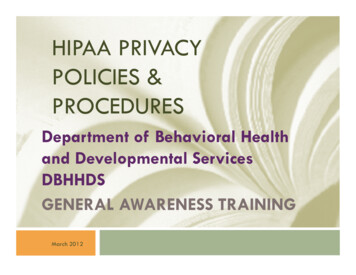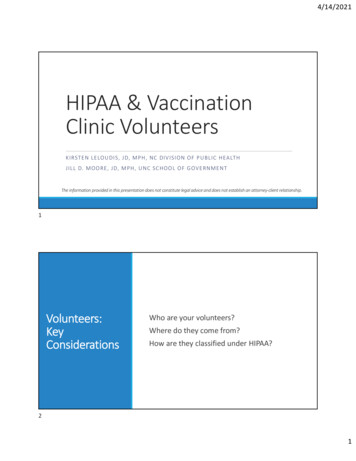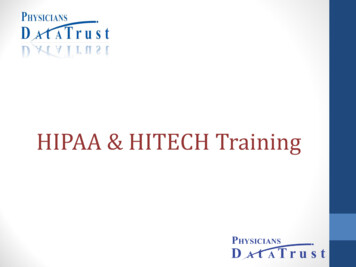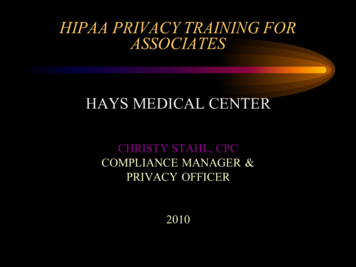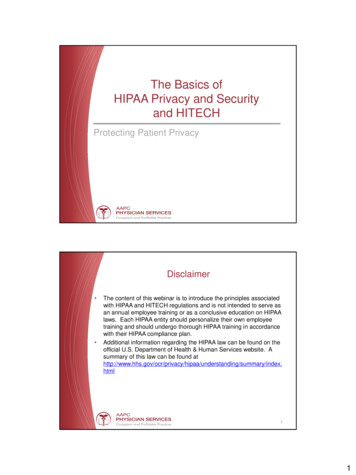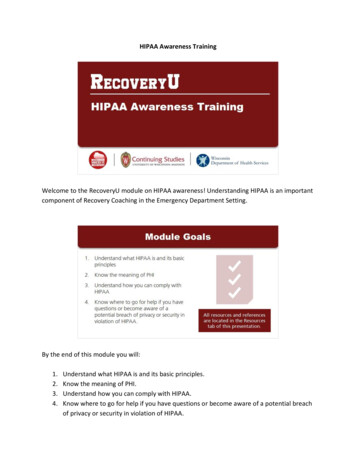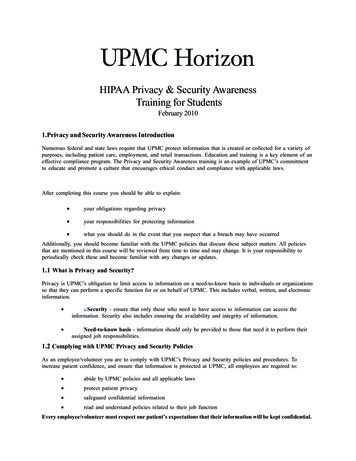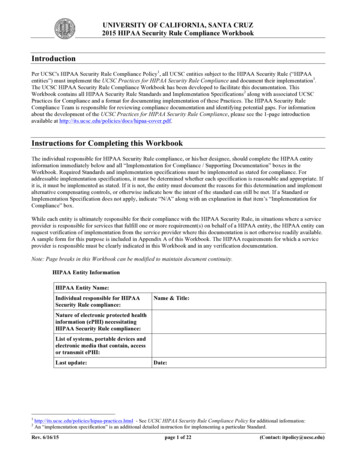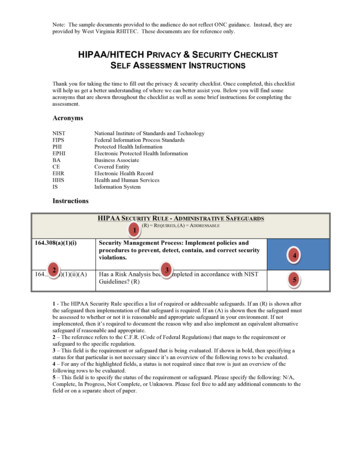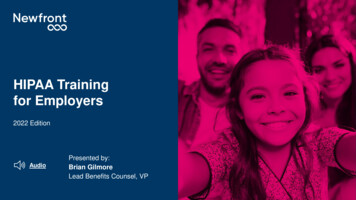
Transcription
HIPAA Trainingfor Employers2022 EditionAudioPresented by:Brian GilmoreLead Benefits Counsel, VP
HIPAA Training for EmployersFrom Portability to Privacy and SecurityGuideTopicsAgenda HIPAA The Health Insurance Portability and Accountability Act of 1996 (HIPAA) Two main branches of HIPAA compliance—Portability and Privacy (most trainings cover onlyPrivacy) This session will cover both aspects of HIPAA, with a focus on the Privacy trainingcomponent HIPAA imposes the only mandatory EB training requirements for employers with self-insuredplans Use this session to satisfy and document your training requirement if you are within theHIPAA firewall!HIPAA Portability and Privacy Topics for Discussion1Portability: HIPAA special enrollment events, ACA eliminates certificates of creditable coverage2Nondiscrimination: HIPAA and ACA’s extensive structure of rules to regulate wellnessprograms3Covered Entities: All employer-sponsored group health plans are HIPAA covered entities4PHI: What qualifies as Protected Health Information, and the big exception for enrollment data5Compliance Strategies: How to avoid a HIPAA breach and satisfy documentation requirements2
Don’t Forget: Document TrainingTemplate EmployeeHIPAA Training SignIn SheetClick here for a fillable pdf employeesign in sheet you can use!3
HIPAA – The Big PictureThe Health Insurance Portability and Accountability Act of 1996 (“HIPAA”)HIPAA Includes Two Main Areas for Employers:HIPAA PortabilityHIPAA Privacy and Security(Technical Name: Administrative Simplification)Pre-ACA (Eliminated in 2014)HIPAA Privacy (Added 2003) Pre-Existing Condition Exclusion Limitations Covered Entity Notices of Creditable Coverage Protected Health InformationStill in Effect Business Associates and BAAs Special Enrollment Events Minimum Necessary Rule Required Mid-Year Enrollment Events Nondiscrimination Based on Health Status Primary Application is to Wellness Programs Breach of Unsecured PHI Notifications (Added 2010) Strategies and SituationsHIPAA Security (Added 2005) Administrative, Physical, and Technical Safeguards4
HIPAA Portability
1. Pre-ACA Issues
ACA PCE ProhibitionEnds Certificates of Creditable CoverageAs of December 31, 2014, health plans are no longer required to provide a HIPAA certificate of creditablecoverage upon the loss of coverage. Reason is that ACA now prohibits health plans from imposing any pre-existing condition exclusions Therefore, individuals will no longer need to provide evidence that they have maintained creditable coverage to avoid pre-existingcondition exclusionsThere is no uniform type of documentation plans will rely on to substantiate a mid-year HIPAA specialenrollment event based on loss of other coverage. In the past, plans and carriers typically relied on the HIPAA certificate of creditable coverage as evidence of the mid-year loss ofcoverage Best alternative is the employer providing a letter on its letterhead stating when coverage under the planterminated (but this should no longer be a HIPAA certificate with obsolete rights listed) Other possible alternatives (from the old pre-2015 regulations, but still useful) include: EOBs or other correspondence from plan or issuer indicating coverage Pay stubs showing payroll deductions for health coverage Third-party statements verifying periods of coverage (e.g., from employer) Phone call from plan or provider to third-party verifying coverage Health ID cards Records from medical providers indicating coverage7
Life After HIPAA CertificatesDocumenting Prior CoveragePreferred alternative to theobsolete HIPAA certificate ofcreditable coverage tosubstantiate a mid-yearHIPAA special enrollmentevent based on loss of othercoverage8
2. SpecialEnrollment Events
HIPAA Special Enrollment EventsRight to Change Medical Plan OptionsWhich Events Qualify?The following events qualify as HIPAA specialenrollment events: Loss of eligibility for other group health coverage orindividual insurance coverage Loss of Medicaid/CHIP eligibility or becoming eligible for astate premium assistance subsidy under Medicaid/CHIP Acquisition of a new spouse or dependent by marriage,birth, adoption, or placement for adoptionThe plan must permit employees to make medicalelection changes as required by HIPAA Upon experiencing a HIPAA special enrollment event, the plan isrequired to allow the employee to select any medical benefitpackage under the plan For example, move from Kaiser to UHC, Cigna to Kaiser, HMOLow to PPO High, etc.General 30-Day Election Period Employees must have a period of at least 30 days from the dateof the event to change their election pursuant to a HIPAA specialenrollment event Longer periods would need to be approved by the insurancecarrier or stop-loss providerMedicaid/CHIP: Special 60-Day Election Period When employees lose Medicaid/CHIP eligibility, or where theygain eligibility for a state premium assistance subsidy underMedicaid/CHIP, they must have at least 60 days from the date ofthe event to change their election This is a good ERISA trivial pursuit question10
HIPAA Special Enrollment EventsEffective Date: Generally First of the Month Following Election The general rule is that an election to enroll in coverage pursuant to a HIPAA special enrollment event must be effective no later thanthe first of the month following the date of the election change request Example 1: Jack marries Jill on April 19, and he submits the election change request to enroll Jill on April 22. Jill’s coverage shouldbe effective no later than May 1. Example 2: Jack marries Jill on April 19, but does not submit the election change request to enroll Jill until May 14. Jill’s coverageshould be effective no later than June 1.Birth/Adoption: Coverage Retroactive to the Date of the Event Where an employee has a new child through birth, adoption, or placement for adoption, coverage for the new child must be effective asof the date of the event In other words, coverage is effective the date of the birth, adoption, or placement for adoption Example: Jack’s spouse Jill gives birth to a child on July 19. Jack submits the election change to enroll the child on August 14. Thechild’s coverage must be effective as of July 19 (the date of birth)Existing Dependents: No Special Enrollment Rights Upon birth, the rules limit the special enrollment rights to the employee, the spouse, and any newly acquired dependents (i.e., thenewborn child) Any other dependents (e.g., siblings of the newborn child) are not entitled to special enrollment rights upon the employee’s acquisitionof the new dependent through birth The exclusion of existing dependents from special enrollment rights prevents the employee from having the right to add an existingchild to the plan upon the birth of the new child11
Outbreak Period Extended TimelinesUnderstanding the “Outbreak Period”The Departments of Labor and the Treasury extended multiple key employee benefits deadlines by disregarding the“Outbreak Period” from the timeline calculation.The National Emergency:The Outbreak Period:From March 1, 2020 to TBDNational Emergency 60 DaysPresident Trump declared a national emergency and invoked anationwide emergency determination under the Stafford Actrelated to COVID-19 effective March 1, 2020.The Outbreak Period is defined as the National Emergencyperiod through 60 days after the end of National Emergencyperiod. FEMA has also issued emergency declarations for every state,territory, and possession in the U.S. Means the Outbreak Period begins March 1, 2020 and ends 60days after the announced end of the National Emergency period Collectively, this is referred to as the “National Emergency” President Biden has continued the period of National EmergencyIn light of the National Emergency, the Departments haveextended multiple key employee benefits timelines. No indication yet of the possible end dateEBSA Disaster Relief Notice 2021-01 caps the maximum perioddisregarded at one year per event Outbreak Period will therefore end the earlier of one year fromthe date the individual was first eligible for the relief, or 60 daysafter the end of the National Emergency12
Outbreak Period Extended TimelinesExtension of HIPAA Special Enrollment PeriodThe Departments of Labor and the Treasury extended multiple key employee benefits deadlines by disregarding the“Outbreak Period” from the timeline calculation.HIPAA Special Enrollment Rules:The Outbreak Period:30-Day and 60-Day WindowsDisregarded for Deadlines30-Day Special Enrollment Period Loss of eligibility for group health coverage or individual healthinsurance coverage Acquisition of a new spouse or dependent by marriage, birth,adoption, or placement for adoption60-Day Special Enrollment Period Loss of Medicaid/CHIP eligibility Becoming eligible for a state premium assistance subsidy underMedicaid/CHIPThe rules extend the 30-day and 60-day HIPAA special enrollmenttimeframes by disregarding the Outbreak Period Example: Employee has new child on 3/31/22 and wants to useHIPAA special enrollment event to enroll child in health plan Assume: National Emergency period ends April 30, 2022, andtherefore the Outbreak Period ends June 29, 2022 Result: Employee would have until 30 days after the end of theOutbreak Period (by July 29, 2022) to enroll No indication yet of actual Outbreak Period end date13
HIPAA Special Enrollment EventsA Subset of Section 125 EventsSection 125 CafeteriaPlan PermittedElection ChangeEvent ChartClick here for a summary overviewof the permitted election changeevents!14
3. Health StatusNondiscrimination(Wellness Programs)
Wellness Program HIPAA/ACA History1996: HIPAA signed into law2006: DOL/IRS/HHS regulations issued in 2006 applying HIPAA nondiscrimination rules to wellness programs HIPAA nondiscrimination rules generally prohibit group health plans from discriminating based on health-related factors withrespect to premiums or cost-sharing Wellness program regulations designed as an exception to the HIPAA nondiscrimination rules for programs that meet therequirements in the regulations2010: ACA codifies 2006 regulations into statute Generally without changes—except for increase to incentive limit from 20% to 30% (and 50% for tobacco cessation) Effective date: Plan years beginning on or after 1/1/142013: DOL/IRS/HHS issues new final regulations based on the ACA (which was primarily a codification of prior 2006final regulations) Started with a statute (HIPAA), followed by regulations (2006), followed by codified regulations (ACA 2010), followed byregulations based on the codified regulations (2013) Plus, new 2013 final regulations claim application to grandfathered plans (even though the ACA specifically exempts) based onoriginal HIPAA authority!16
Federal Laws That MayApply to Wellness Programs1. HIPAA Nondiscrimination(as modified by the ACA)2. ADA3. GINA4. ACA Market Reforms5. ERISA6. COBRA7. HIPAA Privacy/Security8. More? (ADEA, FLSA)
Which Wellness Programs Must Comply?The threshold issue for a wellness program to determine if it must comply with the nine main requirements is whether itis subject to the HIPAA/ACA and the ADA requirements.HIPAA/ACA Threshold QuestionADA Threshold QuestionIs the wellness program a group health plan? An employee welfare benefit plan is a group health plan if itprovides “medical care” “Medical care” generally refers to “the diagnosis, cure, mitigation,treatment, or prevention of disease, or amounts paid for thepurpose of affecting any structure or function of the body” Most wellness programs will fall into this category of group healthplan Any form of blood draws, screening, examinations, assessments,disease management, health incentives, or counseling by trainedprofessionals likely triggers group health plan status Pure referral services, general information for mere promotion ofgood health, or basic educational sessions not customized to theemployee likely are not a group health planDoes the wellness program include:1. Disability-related inquiries; and/or2. Medical Examinations The ADA rules apply to any wellness program that is an“employee health program” that asks employees to respond todisability-related inquiries and/or undergo medical examinations Includes wellness programs that are offered only to employeesenrolled in the employer-sponsored group health plan, offered toall employees regardless of whether they enrolled in theemployer’s plan, or offered by employers that do not offer agroup health plan Examples of “employee health programs” that may trigger theADA regulations include HRAs to determine risk factors, medicalscreening for high blood pressure/cholesterol/glucose, classes tohelp employees stop smoking or lose weight, physical activities(e.g., walking or daily exercise), coaching to help employeesmeet health goals, and/or flu shots18
Two Main Types of Wellness ProgramsFrom the HIPAA Nondiscrimination RulesParticipatory Programs1“If none of the conditions for obtaining a reward under a wellness program is based on an individual satisfying astandard that is related to a health factor (or if a wellness program does not provide a reward), the wellness programis a participatory wellness program.”FHealth-Contingent Programs2“A health-contingent wellness program is a program that requires an individual to satisfy a standard related to ahealth factor to obtain a reward (or requires an individual to undertake more than a similarly situated individualbased on a health factor in order to obtain the same reward). A health-contingent wellness program may be anactivity-only wellness program or an outcome-based wellness program.”19
Two Main Types of Wellness Programs: From HIPAA Nondiscrimination RulesWhich Requirements Apply?1. Participatory Programs2. Health-Contingent Programs1.Program must be available to all similarly situatedindividualsAll six of the participatory program requirements, plusthree more:2.Program must be voluntary*7.Program must offer individuals the opportunity to qualify forrewards at least once per year3.Program must provide reasonable accommodations*8.4.Program must be reasonably designed to promote health orprevent disease*Program must provide reasonable alternative standards (orwaiver of standards) to obtain reward in certain situations5.Program reward/incentive is generally limited to 30% of thecost of coverage*6.ADA wellness program notice provided to employees* Significantly different rules apply for activity-only vs.outcome-based programs9.HIPAA nondiscrimination wellness program noticedescribing reasonable alternative standards included in allplan materials describing the health-contingent wellnessprogram*Important Note: A federal court recently ruled in AARP v. EEOC that the EEOC wellness program rules do not meet the requirements of the ADA, and that theEEOC must issue new regulations meeting certain standards.We feel that the best practice approach is to continue following the vacated EEOC regulations until we have new guidance specifying the ADA requirementsmoving forward.Nonetheless, the HIPAA nondiscrimination rules for wellness programs do remain in effect.20
HIPAAPrivacy/Security
1. Overview
HIPAA Privacy 101 – The BasicsCovered Entity Health Plan Employer-sponsored group health plans Health insurance carriers (including HMOs) Medicare, Medicaid, VA, IHS, TRICARE, etc. Health Care Clearinghouse Health Care Provider (who transmits health information electronically) Doctors, nurses, hospitals, clinics, psychologists, dentists, chiropractors, nursing homes,pharmacies, etc.Business Associate An entity performs a listed function or activity on behalf of a covered entity; andF Creates, receives, maintains, or transmits PHI on behalf of the covered entity Claims processing, data analysis, utilization review, billing, legal, actuarial, accounting, consulting,data aggregationProtected HealthInformation (PHI) Individually identifiable health information maintained or transmitted by a CE or BA Excludes enrollment/disenrollment information used by the employer for employment purposes(that does not include any substantial clinical information)23
HIPAA Key TermsProtected Health Information (PHI)Common Examples of PHI Electronic claims information e-mailed to a group health planby a Third-Party Administrator that contains identifiers An e-mail sent to an insurance carrier or Third-PartyAdministrator about an employee’s claim that includes thehealth condition and an identifier A hard copy or electronic copy of an Explanation of Benefits A claims experience report kept in electronic format or hardcopy that contains identifiers A transition of care form Health Risk Assessments Enrollment/disenrollment information maintained by acovered entity/business associate (i.e., not maintained by theemployer as an employment record)Common Examples of Items That Are Not PHI(And thus not subject to HIPAA privacy and security rules) Employment/HR records with data not collected from acovered entity, including information to comply with otherlaws Such as information collected for FMLA, sick leave, orother similar leaves; alcohol and drug-free workplace lawcompliance; information required by Americans withDisabilities Act; fitness for duty reports Health information from non-health care plans Such as STD/LTD; life insurance; AD&D; business travelaccident; workers’ compensation General health care information Information that is not individually identifiable or did notcome from a HIPAA covered entity/business associate24
The BIG Exception – Enrollment/Disenrollment InformationThe exclusion of enrollment/disenrollment information from the definition of PHI subject to all the HIPAAprotection significantly limits the scenarios where HIPAA applies.Enrollment Information: PHI? Employment records held by the covered entity in its role as employer are not PHI This exclusion from PHI applies to enrollment and disenrollment information held by the employer Such information cannot include any substantial clinical information to qualify for the PHI exemption Significantly limits which and how often employees actually use or disclose PHI Enrollment and disenrollment information held by a covered entity (or business associate) other than the employeris PHI Such entities are not the employer and therefore do not hold such information as employer records25
The BIG Exception – Enrollment/Disenrollment InformationRelevant Cites45 C.F.R. §160.103(2) Protected health information excludes individually identifiable health information: (iii) In employment records held by a covered entity in its role as employer65 Fed. Reg. 82461, 82496“Plan sponsors that perform enrollment functions are doing so on behalf of the participants and beneficiaries of the group healthplan and not on behalf of the group health plan itself. For purposes of this rule, plan sponsors are not subject to the requirements of§ 164.504 regarding group health plans when conducting enrollment activities.”67 Fed. Reg. 53181, 53208“[T]he standard enrollment and disenrollment transaction does not include any substantial clinical information However, theDepartment clarifies that, in disclosing or maintaining information about an individual’s enrollment in, or disenrollment from, a healthinsurer or HMO offered by the group health plan, the group health plan may not include medical information about the individualabove and beyond that which is required or situationally required by the standard transaction and still qualify for the exceptions forenrollment and disenrollment information allowed under the Rule.”26
Questions What was the original purpose of the HealthInsurance Portability and Accountability Act(HIPAA)? Does HIPAA prohibit the use or disclosure ofan individual’s protected health information(PHI)? Does HIPAA prohibit me from listening tosomeone tell me about their medicalproblem? While doing my job, can I be held civillyand/or criminally responsible for a HIPAAviolation?
HIPAA Privacy and SecurityWhy Should Plan Sponsors Care? Any employer that provides group health benefits is affected based on the level of exposure to PHI Employers with self-insured plans effectively are directly subject to the rules Even fully insured plans need to be sensitive to HIPAA Company access to employee health plan records for employment reasons (including administration of benefit plans) is severelylimited Civil and criminal actions may be brought by HHS If HHS fails to act, state attorney generals may bring civil suits Civil monetary penalties can be assessed by HHS, and were significantly increased by HITECHMinimum Penalty perViolationMaximum Penalty PerViolationAnnual Limit 120 60,226 25,000Reasonable Cause 1,205 60,226 100,000Willful Neglect (Timely Corrected) 12,045 60,226 250,000Willful Neglect (Not Corrected) 60,226 60,226 1,806,757CulpabilityNo Knowledge28
HHS Posts Resolution Agreements and Civil Monetary s/compliance-enforcement/agreements/index.html29
HIPAA Civil Liability Case StudyMedical Center’s Unencrypted Laptop and Flash Drive 3 Million HIPAA Settlement Agreement University of Rochester Medical Center paid 3 million in November 2019 to the HHS OCR for two major breaches (2013 and 2017) Unencrypted flash drive containing unsecured PHI lost in 2013 Unencrypted laptop of surgeon containing unsecured PHI stolen in 2017 Severity in part because the Medical Center “failed to implement sufficient mechanisms to encrypt and decrypt ePHI” Also failed to implement security measures sufficient to reduce risks and vulnerabilities despite similar 2010 breach also involving a lostunencrypted flash drive and assistance from HHS OCR to improve policiesBottom Line: Don’t store unencrypted PHI on portable devices! HHS OCR: “Because theft and loss are constant threats, failing to encrypt mobile devices needlessly puts patient health information atrisk When covered entities are warned of their deficiencies, but fail to fix the problem, they will be held fully responsible for theirneglect.” Full details: ance-enforcement/agreements/urmc/index.html30
HIPAA Privacy and SecurityWhy Should Plan Sponsors Care?Potential Criminal PenaltiesCovered entities, business associates, and their employees can be held criminally liable for knowingly violating HIPAAAggravating CircumstancesMaximum FineMaximum ImprisonmentGeneral “Knowingly” Standard 50,000One YearFalse Pretenses 100,000Five YearsIntent to Sell, Transfer, or Use PHI forCommercial Advantage, Personal Gain, orMalicious Harm 250,000Ten YearsThese criminal penalties apply only where there is criminal intent Inadvertent mistakes with respect to HIPAA are not the concern here HIPAA prosecutions occur for situations like identity theft, selling celebrity medical information to the media, Medicare fraud, accessingPHI of individuals the medical practitioner is not treating, etc.31
2. HIPAA Privacy
HIPAA Privacy OverviewPatients Have the Right to Understand and Control How Their Health Information Is Being Used Notice of Privacy Practices: Providers and health plans to give individuals clear, written notice of how they use, keep, and disclosetheir health information Individuals have right to access their medical records (to view, make copies, request amendments, and obtain accounting for nonroutine disclosures) Individual authorizations required before information is released in most non-routine situations Covered entities accountable for use and release of information, with recourse available if privacy is violatedUse of Individual Health Information Generally Limited to Health Purposes PHI generally cannot be used for purposes other than “treatment,” “payment,” or “health care operations” without individualauthorization Individual authorizations must be informed and voluntary Most insurance carriers require use of HIPAA authorizations prior to disclosing PHI with respect to a participant enrolled in aninsured group health plan Minimum Necessary Rule: Reasonable efforts must be undertaken to limit release of information to “minimum necessary amount” Minimum necessary amount requirement applies to use of protected health information for payment or health plan operations, butnot for treatment purposes33
The Big Three Permitted Uses of PHIHIPAA permits covered entities to use or disclose PHI for three different reasons without requiring the individual’sauthorization. These three items are disclosed in the covered entity’s notice of privacy practices and permit the healthcare industry to function smoothly.Treatment1 Providing of care by health care providers Does not apply to health plan covered entities (including employers) Remember that the minimum necessary rule does not apply to treatmentPayment2 To obtain premiums, determine or fulfill responsibility for coverage and provision for benefits under the healthplan, to provide reimbursement Includes eligibility determinations, subrogation, risk adjusting, billing, claims management, collection, stop-loss,medical necessity and utilization reviewHealth Care Operations3 Quality assessment and improvement, patient safety activities, case management, care coordination, informationabout treatment alternatives Underwriting, enrollment, premium rating, and other contractual processes Customer service, plan sponsor data analysis, wellness program operations34
HIPAA Privacy OverviewMinimum privacy safeguard standards established for covered entities (with similarrequirements applicable to business associates and, in some situations, even plan sponsors) Adoption of privacy procedures, with safeguards and sanctions specified Periodic distribution of privacy noticeKey Points toRemember Training of employees on handling PHI Designation of a privacy officer Establishment of a grievance / complaint procedure Recordkeeping with respect to PHI disclosures35
HIPAA Privacy OverviewFully Insured Plans: Reduced Compliance Burden With fully insured plans, both the group health plan and the insurance carrier are HIPAA covered entities Generally, the employer does not need HIPAA policies and procedures documents, to provide employees witha notice of privacy practices, to engage in business associate agreements, or undergo HIPAA training The insurance carrier is directly responsible for those requirements Applies where employers receive only summary health information for limited purposes and enrollment/disenrollmentinformation Most employers offer a health FSA, which is a self-insured group health plan that technically is directly subject tothese HIPAA requirements From a practical perspective, it is common for employers not to take all of the HIPAA steps described above (other than entering intoa BAA with the TPA for the health FSA) where the only self-insured group health plan is the health FSA—although no technicalexemption exists36
When Is Training Required?HIPAA is the only required employee benefits training! But there are a number of restrictive qualifications thatsignificantly limit which employees actually need the training.Only EmployersWith Self-Insured HealthPlan Employers with fully insured plans are not required to train employees Training not required because such employers receive only summary healthinformation for limited purposes and enrollment/disenrollment informationOnly EmployeesWithin the HIPAA Firewall Only those employees with a plan-related need to access PHI for plan administrativefunctions are within the HIPAA firewall These are the only employees who have access to PHI—and therefore the onlyemployees who need training in how to handle PHIOnly New Hires andUpon a Material Change inPolicies and Procedures Training required within a “reasonable period of time” after hire After the initial training, re-training required only upon a material change in the plan’sHIPAA privacy policies and procedures Best practice: Retrain once every two years regardless of changes37
Self-Insured PlansWhen Is a BAA Required? HIPAA business associates can include third-parties in many different areas that create, receive, maintain, or transmitPersonal Health Information Examples include (but are not limited to): Claims processing or administration, data analysis, legal, actuarial, accounting, consulting, data aggregation, administrative,financial services Employers cannot permit such third-party vendors (business associates) to access PHI under their self-insured planwithout entering into a BAA on behalf of the health plan (the HIPAA covered entity) Fully insured plans generally do not need HIPAA BAAs Note that enrollment/disenrollment information maintained by the employer (that does not include any substantive clinicalinformation) is not PHI BAA will impose certain required safeguards on the business associates related to HIPAA privacy and securitycompliance Note that the HITECH Act also imposes direct HHS liability on business associates—regardless of the terms of the BAA38
Disclosing PHI to Family MembersGeneral rule is that the individual must authorize disclosure of PHI that is not to a covered entity or business associate fortreatment, payment, or health care operations.In some limited situations, the covered entity (e.g., the health plan) may disclose PHI to a family member or close personal friend if thePHI is directly relevant to their involvement to assist in the individual’s care or payment.This issue often arises with parents assisting a pre-26 adult child with treatment/payment.Individual Has Capacity to Make Health CareDecisionsIndividual Not Present, Incapacitated, or EmergencyCovered entity may disclose if:Covered entity may disclose if: Obtains agreement
HIPAA nondiscrimination rules generally prohibit group health plans from discriminating based on health-related factors with respect to premiums or cost-sharing Wellness program regulations designed as an exception to the HIPAA nondiscrimination rules for programs that meet the
